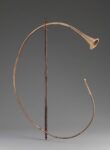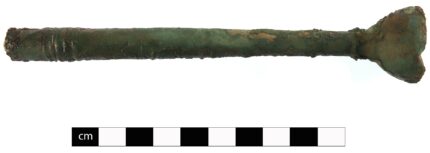An extremely rare mouthpiece from a Roman cornu — a long, curled horn — has been discovered beneath the remains of the ancient officer’s club at the Vindolanda Roman fort just south of Hadrian’s Wall. Made of copper alloy, the mouthpiece was found over a Hadrianic-era (117-138 A.D.) workshop floor. The stratigraphy dates it to 120-128 A.D.
The cornu (Latin “horn”, both musical and animal) was an instrument around 3m long, curled into a letter ‘G’ shape and was commonly supported by a wooden pole, allowing for some of the weight to be held on the shoulder. Cornua are depicted in many Roman settings on imagery with military, ceremonial and entertainment use.
Vindolanda is famed for the thousands of fragile organic artifacts recovered intact from its anaerobic water-logged soil, most famously almost 800 wooden letter tablets recording the daily lives of Vindolanda’s military and civilian residents. More than 7,000 leather objects and 1,500 wooden ones have been found in excavations at the site, including thousands of leather shoes, the only surviving Roman wooden toilet seat and the only surviving pair of Roman leather boxing gloves. Even in the midst all this archaeological pulchritude, the cornu mouthpiece stand out as the only one of its kind discovered at Vindolanda.
 A cornu was a G-shaped brass instrument without holes or valves. It was played by controlling air flow, similar to a French horn. Its design was of Etruscan origin, but the Romans made it their own a military signalling device. Cornicenes played loud notes to convey orders to the army on the march and in battle. Several large examples were found in Pompeii and exact replicas have been used to reproduce the sound of Roman armies at war.
A cornu was a G-shaped brass instrument without holes or valves. It was played by controlling air flow, similar to a French horn. Its design was of Etruscan origin, but the Romans made it their own a military signalling device. Cornicenes played loud notes to convey orders to the army on the march and in battle. Several large examples were found in Pompeii and exact replicas have been used to reproduce the sound of Roman armies at war.
 (Side note, found while investigating the Metropolitan Museum of Art’s replica of the Pompeii horn: an 1888 Duke cigarette company trade card with a bijou version of a cornu encircling the soft shoulder of a pinup girl.)
(Side note, found while investigating the Metropolitan Museum of Art’s replica of the Pompeii horn: an 1888 Duke cigarette company trade card with a bijou version of a cornu encircling the soft shoulder of a pinup girl.)
One of the replica Pompeiian cornua will celebrate the discovery of the mouthpiece with a live performance at Vindolanda this Sunday by musician Letty Scott. The mouthpiece has undergone conservation and will soon go on display at the Roman Army Museum of Vindolanda.
Here is a great video of musician Abraham Cupeiro putting one of the Pompeiian replicas through its paces.
